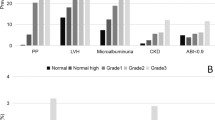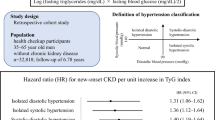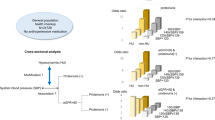Abstract
Increased urine albumin excretion is associated with an unfavourable cardiovascular risk profile and prognosis in primary hypertension, even though its pathogenesis is currently unknown. Microalbuminuria (Mi) has been proposed as an integrated marker to identify patients with subclinical organ damage, but its routine use is still too often neglected in clinical practice. The aim of our study was to evaluate the relationship between urinary albumin excretion and early signs of subclinical target organ damage (TOD), namely left ventricular hypertrophy and carotid atherosclerosis in a large group of non diabetic hypertensive patients. A group of 346 never treated patients with primary hypertension (212 men, 134 women, mean age 47 ± 9 years) referred to our clinic were included in the study. They underwent the following procedures: (1) family and personal medical history and physical examination; (2) clinical blood pressure measurement; (3) routine blood chemistry and urine analysis including determination of urinary albumin excretion (ACR); (4) electrocardiogram; (5) ultrasound evaluation of left ventricular mass (LVMI) and carotid artery thickness (IMT). The overall prevalence of Mi, left ventricular hypertrophy, and carotid plaque was 13, 51, and 24% respectively. Mi was significantly correlated with LVMI (P < 0.0001), IMT (P < 0.0001) and several metabolic and non-metabolic risk factors (blood pressure, body mass index, serum lipids). Cluster analysis identified three subgroups of patients who differ significantly with regards to TOD and albuminuria (P ⩽ 0.001 for each of the examined variables). Patients with higher IMT and LVMI values also showed increased ACR levels. Furthermore, patients with microalbuminuria were more likely to have both LVH and IMT values above the median for the study population (OR 21, C.I. 4.6–99.97, P < 0.0001). Mi is an integrated marker of subclinical organ damage in patients with primary hypertension. Evaluation of urinary albumin excretion is a specific, cost-effective way to identify patients at higher risk for whom additional preventive and therapeutic measures are advisable.
This is a preview of subscription content, access via your institution
Access options
Subscribe to this journal
Receive 12 digital issues and online access to articles
$119.00 per year
only $9.92 per issue
Buy this article
- Purchase on Springer Link
- Instant access to full article PDF
Prices may be subject to local taxes which are calculated during checkout


Similar content being viewed by others
References
The sixth report of the Joint National Committee on prevention, detection, evaluation, and treatment of high blood pressure Arch Intern Med 1997; 157: 2413–2446
Chalmers J et al. World Health Organization-International Society of Hypertension Guidelines for the management of hypertension. Guidelines sub-committee of the World Health Organization Clin Exp Hypertens 1999; 21: 1009–1060
Pontremoli R . Microalbuminuria in essential hypertension – its relation to cardiovascular risk factors Nephrol Dial Transplant 1996; 11: 2113–2115
Bianchi S, Bigazzi R, Campese VM . Microalbuminuria in essential hypertension: significance, pathophysiology, and therapeutic implications Am J Kidney Dis 1999; 34: 973–995
Borch-Johnsen K et al. Urinary albumin excretion. An independent predictor of ischemic heart disease Arterioscler Thromb Vasc Biol 1999; 19: 1992–1997
Jensen JS et al. Arterial hypertension, microalbuminuria, and risk of ischemic heart disease Hypertension 2000; 35: 898–903
Viberti G, Thomas S . Should we screen for microalbuminuria in essential hypertension? Am J Kidney Dis 1999; 34: 1139–1141
Friedewald WT, Levy RI, Fredrickson DS . Estimation of the concentration of low density lipoprotein cholesterol in plasma without use of the preparative ultracentrifuge Clin Chem 1972; 18: 499–502
Cockcroft WD, Gault MH . Prediction of creatinine clearance from serum creatinine Nephron 1976; 16: 31–34
Pontremoli R et al. Prevalence and clinical correlates of microalbuminuria in essential hypertension. The MAGIC study Hypertension 1997; 30: 1135–1143
Mangili R et al for the Italian Microalbuminuria Study Group. Prevalence of hypertension and microalbuminuria in adult type 1 (insulin dependent) diabeticpatients without renal failure in Italy. Validation of screening techniques to detect albuminuria Acta Diabetol 1992; 29: 156–166
Sokolow M, Lyon TP . The ventricular complex in left ventricular hypertrophy as obtained by unipolar precordial and limb reads Am Heart J 1949; 37: 161–186
Casale PN et al. Improved sex-specific detection of left ventricular hypertrophy: development and prospective validation of improved criteria J Am Coll Card 1985; 6: 572–580
Schiller NB et al. Recommendations for quantitation of the left ventricle by two dimensional echocardiography: American Society of Echocardiography Committee on standards, subcommittee on quantitation of two-dimensional echocardiograms J Am Soc Echocardiogr 1989; 2: 358–367
Devereux RB et al. Echocardiographic assessment of left ventricular hypertrophy: comparison to necropsy findings Am J Cardiol 1986; 57: 450–458
De Simone G et al. Effect of growth on variability of left ventricular mass: assessment of allometric signals in adults and children and their capacity to predict cardiovascular risk J Am Coll Cardiol 1995; 25: 1056–1062
Savage DD et al. The spectrum of left ventricular hypertrophy in a general population sample: the Framingham study Circulation 1987; 75 (Suppl I): I-26–1-33
Kawagishi T et al. High-resolution B-Mode ultrasonography in evaluation of atherosclerosis in uremia Kidney Intern 1995; 48: 820–826
Weldelhag I, Wiklund O, Wikstrand J . Atherosclerotic changes in the femoral and carotid arteries in familial hypercholesterolemia: ultrasonographic assessment of intima-media thickness and plaque occurrence Arterioscler Thromb 1993; 13: 1404–1411
Tryon RC, Bailey D . Cluster Analysis McGraw-Hill Book Co: New York 1970; pp 1–347
Pontremoli R et al. Left ventricular geometry and function inpatients with essential hypertension and microalbuminuria J Hypertens 1999; 17: 993–1000
Bigazzi R et al. Increased Thickness of carotid artery inpatients with essential hypertension and microalbuminuria J Hum Hypertens 1995; 9: 827–833
Pedrinelli R . Microalbuminuria in essential hypertension Nephron 1996; 73: 499–505
Pedrinelli R et al. Microalbuminuria and endothelial dysfunction in essential hypertension Lancet 1994; 344: 14–18
Pontremoli R et al. Prevalence of micro- and macroalbuminuria and their relationship with other cardiovascular risk factors in essential hypertension Nephrol Dial Transplant 1995; 10 (Suppl 6): 6–9
Campese VM, Bianchi S, Bigazzi R . Association between hyperlipidemia and microalbuminuria in essential hypertension Kidney Int 1999; 71: S10–S13
Agewall S, Lindstedt G, Fagerberg B . Independent relationship between microalbuminuria and plasminogen activator inhibitor-1 activity (PAI-1) in clinically healthy 58-year-old men Atherosclerosis 2001; 157: 197–202
Baldoncini R et al. High plasma renin activity is combined with elevated urinary albumin excretion in essential hypertensivepatients Kidney Int 1999; 56: 1499–1504
Acknowledgements
This work was supported in part by grant no RF99.52 from Ministero della Sanità, Ricerca Finalizzata 1999. The excellent technical help of Cinzia Tomolillo, BS is gratefully acknowledged.
Author information
Authors and Affiliations
Corresponding author
Rights and permissions
About this article
Cite this article
Leoncini, G., Sacchi, G., Ravera, M. et al. Microalbuminuria is an integrated marker of subclinical organ damage in primary hypertension. J Hum Hypertens 16, 399–404 (2002). https://doi.org/10.1038/sj.jhh.1001408
Received:
Revised:
Accepted:
Published:
Issue Date:
DOI: https://doi.org/10.1038/sj.jhh.1001408
Keywords
This article is cited by
-
The ratio of AGE to sRAGE independently associated with albuminuria in hypertensive patients
BMC Endocrine Disorders (2018)
-
A multicenter cohort study of primary hypertension in Korea: study design and interim analysis of the Korean registry of target organ damage in hypertension (KorHR)
Clinical Hypertension (2017)
-
Proteinuria and Clinical Outcomes in Hypertensive Patients
American Journal of Hypertension (2009)
-
Reduction of proteinuria with angiotensin receptor blockers
Nature Clinical Practice Cardiovascular Medicine (2008)
-
Left Ventricular Hypertrophy and Clinical Outcomes in Hypertensive Patients
American Journal of Hypertension (2008)



